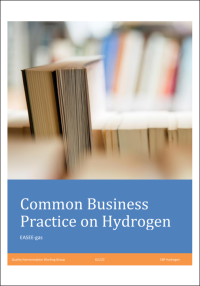EASEE-gas Board agreed to draft a Common Business Practice (CBP) for the harmonisation of the recommended quality specification for hydrogen flowing through dedicated systems for conveying hydrogen and newly built hydrogen pipeline systems.
 In 2019 the EASEE-gas Board agreed to draft a Common Business Practice (CBP) for the harmonisation of the recommended quality specification for hydrogen (non-blended with natural gas, see Note 1) flowing through dedicated systems, meaning networks that were originally designed and used for natural gas transmission and after a safety and reliability assessment (see Note 2) found suited for conveying hydrogen and newly built hydrogen pipeline systems.
In 2019 the EASEE-gas Board agreed to draft a Common Business Practice (CBP) for the harmonisation of the recommended quality specification for hydrogen (non-blended with natural gas, see Note 1) flowing through dedicated systems, meaning networks that were originally designed and used for natural gas transmission and after a safety and reliability assessment (see Note 2) found suited for conveying hydrogen and newly built hydrogen pipeline systems.
This CBP focusses on ‘industrial grade’ hydrogen because it is expected that in the coming years, the large-scale production of hydrogen, necessary to operate a pipeline system, will partly take place by chemical conversion of hydrocarbons. In contrast to electrolysis, these processes do not deliver inherent fuel cell quality hydrogen. Possibilities for large scale production of hydrogen via electrolysis are not expected before 2030. Another reason to focus on ‘industrial grade’ hydrogen is the observation from market forecasts that the industry will take the lion share of the total hydrogen production. Only in the period after 2030, there is a possibility for large scale demand for fuel cell and/or energy production grade hydrogen. Last but not least, no hands-on experience is available on the possible effects of residues in the pipeline resulting from the previous exposure to natural gas on the hydrogen transmitted through such a pipeline. The risk that small amounts of a particular contaminant result in an off-specification at the exit increases with an increase of the minimum hydrogen purity.
